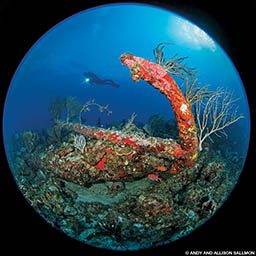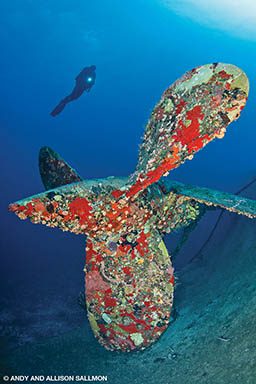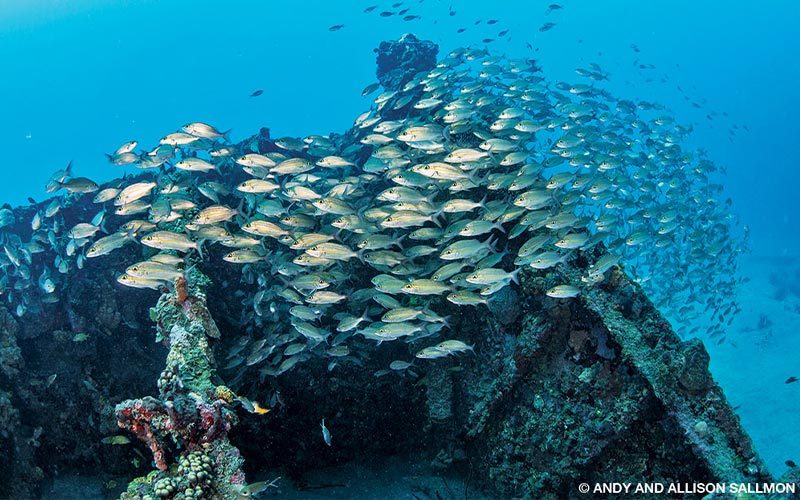We are gearing up on the deck of our dive boat when we hear the roar of an airplane — a jet. Everyone on the boat stares at the sky in shock, and a flurry of surprised discussion erupts among the crew. The key theme: What the hell is that doing here?

We watch with interest because after a few days on St. Eustatius the background din of our normal lives has become a distant memory. This place is quiet. It’s so quiet that we’re awakened every morning by the clacking of goat hooves on our porch, so quiet that we know it’s time to mosey over to the dive shop because we can hear the morning flight (a tiny prop plane) approaching the island with an understated whine. A stray airliner? That’s as discordant as it gets.
It wasn’t always so quiet here. Two and a half centuries ago, St. Eustatius (Statia, for short) had a tariff-free trade policy, a distinction that made it one of the busiest shipping ports in the world and earned it the nickname “the Golden Rock.” On Nov. 16, 1776, the bustling island was the first foreign nation to acknowledge America’s fledgling independence with a gun salute to the U.S. flag, which was a big deal, especially to Great Britain. The island’s economy survived the political backlash that followed but not the abolition of slavery a few decades later, and it didn’t take long for Statia’s popularity — and population — to plummet. The Golden Rock quickly faded to obscurity.
Fast forward to 1996: The St. Eustatius National Marine Park was established. And then…not much. For the past two decades Statia has remained obscure, while the marine life surrounding it has grown and proliferated. A rich reef environment arose around this island with such a rich past.
An Anchoring Principle
Statia is infused with history, a fact that is especially apparent from a dive boat. Fort Oranje overlooks the harbor, the crumbling walls of old warehouses line the shore, and nearly every dive site includes man-made elements such as ballast stones, cannons and, most of all, anchors. Early on the first dive day our dive guide points out an anchor, a huge fan- and sponge-covered beauty embedded in the reef at Anchor Point. The artifact is photographed and largely forgotten once we spot a large hawksbill turtle swimming past us, but its significance sinks in when we begin to spot anchors (sometimes in multiples) at sites all around the island. It makes sense, of course. Hundreds of ships went down in these waters during the island’s heyday, and after all this time the anchors are the easiest remains to spot.
Not all historical details announce themselves in such an obvious fashion. The Old City Wall, a shore dive that’s accessible on calm days, is a haven for tiny creatures. Other than the site name and the wall’s suspiciously straight lines, its man-made nature is concealed by sponge and coral, which make a picturesque home for blennies, gaudy clown crabs and other tiny creatures. Since it is one of the few named sites in Statia shallower than 55 feet, it promptly becomes our third-dive-of-the-day favorite.
At Blue Bead Hole, on the other hand, artifacts are the name of the game. This sandy site located just outside of the harbor is one of the most common spots for divers to unearth a Dutch blue bead, the currency once used on the island. Our dive guide tells us that according to legend, the beads seek the finder rather than the other way around, so it’s best to stick together and stay well off the bottom. Of course this sounds like hooey to our group, and the resulting dive-turned-treasure-hunt has the ambiance of a controlled free-for-all. Although no blue beads find us (perhaps the result of our rebelliousness), we spot a pair of jewel-colored flying gurnards floating calmly above the sand.
The Power of Positive Sinking

Statia’s maritime artifacts are fascinating, but shipwreck fanatics are generally keen to explore something that’s a bit more intact. Fortunately, the island’s government recognized this desire years ago, and multiple purposely sunk wrecks are now part of the island’s reef system. The crown jewel is the Charles L. Brown, a 320-foot cable-laying ship acquired in 2002. This behemoth, one of the largest wreck dives in the Caribbean, now lies on its starboard side at 100 feet, often enclosed by a large shoal of jacks. It takes two dives to complete a cursory inspection of the colorful fan- and sponge-covered structure. We keep an eye out for the famous giant barracuda that frequents the site. We diligently search the radar antenna, the fantastic propeller and the wheelhouse before we discover the oversize fish watching us from a hatch with a spooky, toothy leer.
The Chien Tong is equally worthy of high marks. This 170-foot Taiwanese fishing trawler, sunk in an upright position in 2004, is equally sponge-encrusted, a bit shallower (in 80 feet of water), and surrounded by sand flats and seagrass beds that are frequented by abundant marine life. We try to concentrate on inspecting the propeller, but we’re immediately distracted by the large stingrays feeding nearby. Relocating to the deck doesn’t help our focus, as jacks and snapper whirl overhead, and green turtles pass by at what seems to be every few minutes. Back on the surface, the dive guide says, “If you think this is a good daytime dive, wait until you see it at night. The turtles come here to sleep, and it’s one of the best night dives in the Caribbean.”
We’re a little dubious about the wreck-diving-at-night thing, but we gamely return the next night. We’re still descending when we happen across our first sighting, a small green turtle swimming sluggishly across the upper deck, but it isn’t until we reach the stern that we fully understand the hype. A huge sleeping hawksbill turtle is wedged halfway into a narrow doorway, head down, butt floating toward the ceiling. My light catches a flash of white next to its head — a toilet. We begin laughing uncontrollably, feeling like we’ve happened across the aftermath of a raucous, booze-fueled bash. Several other large hawksbills are strewn around the ship, although the others are in slightly more dignified positions: crammed under the deck railing, for instance, or face-first behind a winch. We have to hand it to the guide — if this isn’t the very best night dive we’ve ever experienced, it’s certainly the most comical.

Named after and created by the St. Eustatius National Parks Foundation (STENAPA), nearby STENAPA Reef might be the biggest surprise of all. This mishmash of sunken structures — including a harbor boat, the Golden Rock tugboat and a couple of chunks of a tanker with an embedded anchor (naturally) — has attracted more marine life than we’d have thought possible. One of the tanker sections is hidden behind a shifting wall of grunts. Jabba-the-Hutt-like stingrays litter the sand, and the tugboat is so dense with sponge and coral that it looks like a parade float. We see giant barracuda and a quartet of French angelfish. And like we have encountered at several other sites, we see lobsters — many, many lobsters.
A Place for Lobsters

There is no question that Statia’s reefs are amazingly healthy. Hangover Reef is a series of ledges that are distractingly coated in multicolored sponges and fans with the occasional hawksbill turtle or school of snapper passing by. We find nurse sharks sleeping at Nursing Station, while a school of squirrelfish hovers prettily in front of a sponge-dotted overhang. We’re also introduced to a particularly mind-blowing example of reef richness at an offshore site called Lost Anchors. After backrolling into a school of giant barracuda, we are greeted by a large stingray on the reef and are eyed at a distance by at least five different Caribbean reef sharks as we search diligently for the site’s namesake artifacts.
The lobsters are the thing though. Except when perusing a menu or hunting, most divers may not give lobsters a lot of thought, and why would they? During daylight hours, lobsters typically prefer to hide in crevices rather than cavort in the open. Their presence is generally considered a major indicator of reef health, and by this criterion, Statia has phenomenally healthy reefs.
The Double Wreck site hammers this home. It’s incredible what the ocean can do with the remains of two 18th-century trading ships (i.e., some old ballast stones and a pair of anchors) spread over a few sand patches and some seagrass beds. Coral, sponges and gorgonians have grown like gangbusters from the wreckage, turtles munch away in the seagrass, and stingrays feed in the sand. Crawling all over the whole lot are so many large lobsters that I lose count. We swim toward a particularly populated rock, expecting the lobster herd to scatter nervously, but instead several of them approach with doglike curiosity. One tries to clamber onto my camera. Yet another stares at me contentedly from a barrel sponge less than a foot away. I look it in the eyes and vow never to eat lobster again. We return to this site on our final day, ending our dive by watching the lobsters clustered on the rock. As we ascend I take one last, long look at them, watching their antennas sway skyward in a vigorous, soundless farewell.
How to Dive It
Getting there: St. Eustatius is in the Eastern Caribbean. Many international airlines fly into St. Maarten. From there, Winair offers several flights daily to St. Eustatius; flights are strictly weight limited, and luggage may be delayed (normally less than a day), so pack critical items in carry-on bags. Ask if your dive shop offers free access to rental gear for divers awaiting baggage. Dutch is the official language, but French and English are also widely spoken. The local currency is the U.S. dollar. Cash is the preferred payment method around the island; many vendors do not accept credit cards.

Conditions and diving: Thanks to mild northeast trade winds throughout the year, the island has a pleasant climate. Hurricane season is June through November; although St. Eustatius lies in the storm track for hurricanes, it is rarely hit. Water temperatures range from 79°F in winter to 86°F in the summer; a 3-5 mm wetsuit is recommended year-round. Visibility is good to excellent, ranging from more than 100 feet on the offshore reefs to 30-50 feet in the bay. Although the diving here is suitable for novice to intermediate divers, few sites are shallower than 55 feet. For this reason nitrox certification is highly recommended; our dive shop offered free nitrox to all divers to encourage its use. There is a hyperbaric chamber on the island.
Preservation and conservation: Statia has a long maritime history dating back several hundred years. Artifacts and old wreck sites abound. The St. Eustatius National Park Foundation (STENAPA) manages all of the island’s protected areas, including the Statia National Marine Park, the Quill/Boven National Park and the Miriam C. Schmidt Botanical Garden. The marine park extends around the island to a depth of 98 feet. Except for Dutch blue beads, nothing (historical artifacts or marine life) may be removed from the marine park. All dives on Statia must be conducted with a guide from a local dive center, and the use of gloves is not permitted in most circumstances.
© Alert Diver — Q2 2017